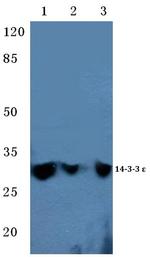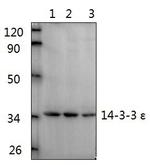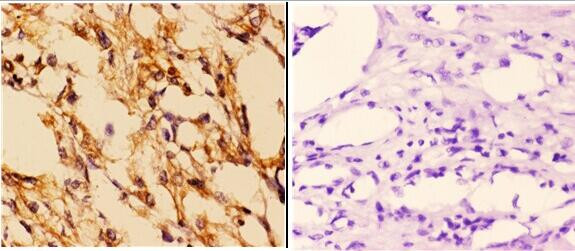Search Thermo Fisher Scientific
FIGURE: 1 / 6
14-3-3 epsilon Antibody (PA5-86411) in IHC (P)






Product Details
PA5-86411
Species Reactivity
Host/Isotype
Class
Type
Immunogen
Conjugate
Form
Concentration
Purification
Storage buffer
Contains
Storage conditions
Shipping conditions
RRID
Product Specific Information
Purity is > 95% by SDS-PAGE.
Target Information
14-3-3 epsilon belongs to the 14-3-3 family of proteins which mediate signal transduction by binding to phosphoserine-containing proteins. This highly conserved protein family is found in both plants and mammals, and this protein is 100% identical to the mouse ortholog. It interacts with CDC25 phosphatases, RAF1 and IRS1 proteins, suggesting its role in diverse biochemical activities related to signal transduction, such as cell division and regulation of insulin sensitivity. It has also been implicated in the pathogenesis of small cell lung cancer. Two transcript variants, one protein-coding and the other non-protein-coding, have been found for this gene.
For Research Use Only. Not for use in diagnostic procedures. Not for resale without express authorization.
References (0)
Bioinformatics
Protein Aliases: 14-3-3 epsilon; 14-3-3 protein epsilon; 14-3-3E; epididymis luminal protein 2; mitochondrial import stimulation factor (MSF) L subunit; Mitochondrial import stimulation factor L subunit; MSF L; protein kinase C inhibitor protein-1; tyrosine 3-monooxygenase/tryptophan 5-monooxygenase activation protein, epsilon polypeptide; tyrosine 3-monooxygenase/tryptophan 5-monooxygenase activatioprotein epsilon polypeptide; tyrosine 3-monooxygenase/tryptophan 5-monooxygenase activatioprotein, epsilon polypeptide; tyrosine 3/tryptophan 5 -monooxygenase activation protein, epsilon polypeptide
Gene Aliases: 14-3-3E; AU019196; HEL2; KCIP-1; MDCR; MDS; YWHAE
UniProt ID: (Human) P62258, (Rat) P62260, (Mouse) P62259
Entrez Gene ID: (Human) 7531, (Rat) 29753, (Mouse) 22627

Performance Guarantee
If an Invitrogen™ antibody doesn't perform as described on our website or datasheet,we'll replace the product at no cost to you, or provide you with a credit for a future purchase.*
Learn more
We're here to help
Get expert recommendations for common problems or connect directly with an on staff expert for technical assistance related to applications, equipment and general product use.
Contact tech support
